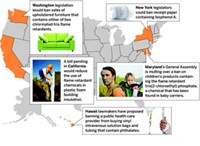Advertisement
Grab your lab coat. Let's get started
Welcome!
Welcome!
Create an account below to get 6 C&EN articles per month, receive newsletters and more - all free.
It seems this is your first time logging in online. Please enter the following information to continue.
As an ACS member you automatically get access to this site. All we need is few more details to create your reading experience.
Not you? Sign in with a different account.
Not you? Sign in with a different account.
ERROR 1
ERROR 1
ERROR 2
ERROR 2
ERROR 2
ERROR 2
ERROR 2
Password and Confirm password must match.
If you have an ACS member number, please enter it here so we can link this account to your membership. (optional)
ERROR 2
ACS values your privacy. By submitting your information, you are gaining access to C&EN and subscribing to our weekly newsletter. We use the information you provide to make your reading experience better, and we will never sell your data to third party members.
Environment
Concern Over Bisphenol A And Phthalates Spurs State Legislation
by Bette Hileman
March 12, 2007
| A version of this story appeared in
Volume 85, Issue 11
The adverse developmental effects associated with exposure to bisphenol A (BPA) and phthalates discussed at a recent conference on the impacts of environmental contaminants convened by the University of California, San Francisco, are motivating state and local initiatives to restrict use of these compounds.
Most recently, a bill was introduced on Feb. 27 in the California Assembly that would keep BPA and certain phthalates out of toys and child care products intended for children under the age of three. The bill, A.B. 1108, is modeled after an ordinance that Assemblywoman Fiona Ma wrote while a member of the Board of Supervisors in San Francisco. That ordinance gained unanimous approval in July.
In the bill, di(2-ethylhexyl) phthalate (DEHP), dibutyl phthalate (DBP), and benzyl butyl phthalate (BBP) in concentrations exceeding 0.1% are prohibited in all child care articles for babies. The bill calls for a ban on three other phthalates in products that can be placed in a child's mouth. If A.B. 1108 is enacted, it will go into effect in January 2009.
The bill was introduced on the same day as the release of a report prepared by the advocacy group Environment California. The group had laboratory tests done to measure the leaching of BPA from five popular brands of polycarbonate baby bottles after the bottles had been subjected to what the group claims were realistic dishwasher conditions. The tests showed that BPA leaches into liquids placed in the bottles after washing.
"The alarming findings of this report are even further evidence of the need for legislative action," says Ma, who is the majority whip in the Assembly. "Now is the time to remove dangerous toxics from store shelves."
According to Frederick S. vom Saal, a biologist at the University of Missouri, Columbia, the concentrations of BPA that leached from the baby bottles in tests ordered by Environment California are 100 times higher than the levels that disrupt hormones and cause changes in mammary glands of lab animals.
But many other researchers have conducted studies of BPA released from baby bottles and found very low levels, says Steven Hentges, executive director of the polycarbonate/BPA group at the American Chemistry Council.
Industry groups and toy makers have filed lawsuits against the San Francisco ordinance on BPA and phthalates. They claim these chemicals are safe and that the federal government, not the states or cities, has jurisdiction over product safety.
Bills similar to A.B. 1108 died in the state legislatures of California, Minnesota, and Maryland last year due to industry lobbying.
- Chemical Exposures
- Unusual cross-disciplinary meeting explores effects of environmental compounds on human development and reproduction
- Improving Health
- Moving From Research To Public Policy
- Product Safety
- Concern Over Bisphenol A And Phthalates Spurs State Legislation





Join the conversation
Contact the reporter
Submit a Letter to the Editor for publication
Engage with us on Twitter